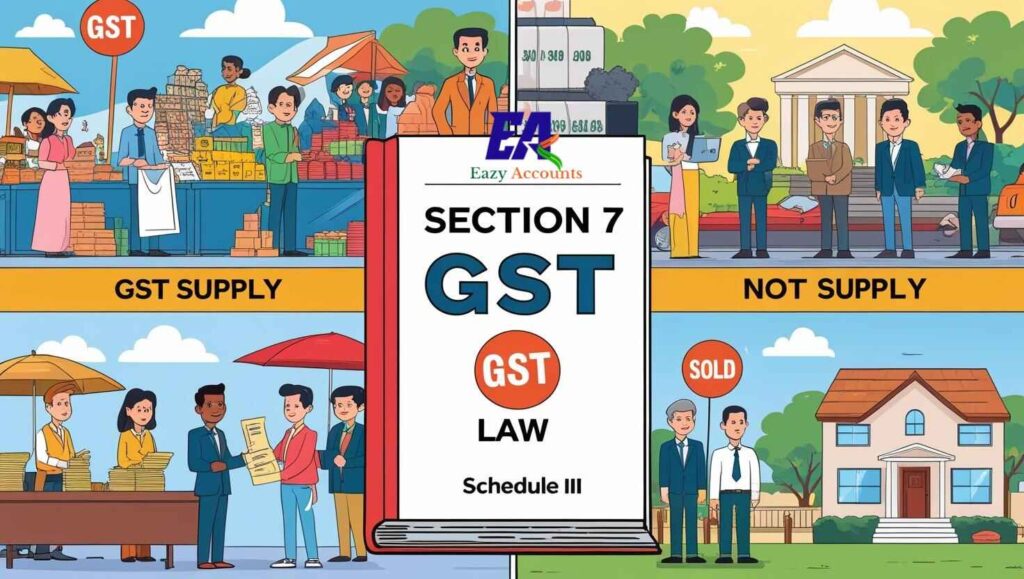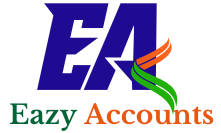If GST were a movie, the first scene would be about “Supply”. Why? Because without supply, there’s no GST at all. The law doesn’t just tax goods and services – it taxes the supply of goods and services.
But here’s the twist: not everything you give, sell, or exchange counts as a “supply” under GST. Some transactions are fully taxable, some are exempt, and a few are so far outside the GST net that the law says, “Don’t even think about taxing these.”
In this guide, we’ll break down Scope of Supply under GST as per Section 7 of the GST Act – the part of the law that defines what supply means – and then look at Schedule III, which lists activities that are neither goods nor services. By the end, you’ll know exactly what falls inside GST, what stays outside, and why it matters for your compliance, turnover calculations, and input tax credit (ITC) rules.

What is Supply under GST?
Section 7(1) of the GST Act gives us the official definition. In simple terms, a supply means:
“Any form of supply of goods or services or both, made for a consideration, in the course or furtherance of business.”
Sounds simple, right? But the law adds layers – so let’s peel them one by one.
1. All Forms of Supply
Supply is not limited to selling goods. It includes:
- Sale – e.g., selling a mobile phone.
- Transfer – giving away ownership of a truck to another business.
- Barter or Exchange – swapping products or services without money (yes, GST still applies).
- Licence, Rental, Lease – giving rights or temporary possession for a fee.
- Disposal – discarding business assets for value.
If it involves goods or services, happens for consideration (money or something of value), and is part of your business, it’s likely a supply.
2. Special Case: Transactions with Members (Clause aa)
Even if you think a club and its members are the same, GST law says they are separate persons.
- Example: A club charging membership fees is making a supply to its members — GST applies.
- This rule came after court judgments earlier tried to say such fees were not taxable.
3. Import of Services
If you import services for a consideration, GST applies whether or not it’s for business.
- Example: Paying an overseas designer to make your wedding invitations? GST liability may arise under reverse charge.
4. Supplies Without Consideration (Schedule I)
Certain transactions are treated as supply even without payment, such as:
- Stock transfers between branches in different states.
- Free samples to related parties.
5. Classifying Supply (Section 7(1A) & Schedule II)
Once something is a supply, it’s classified as goods or services using Schedule II.
- Example: Renting out land is a service.
- Works contracts are always treated as services.
What is NOT in the Scope of Supply under GST?
Section 7(2) is the “exemption gate” for certain activities. It says — even if something looks like a supply, it will not be treated as one if it falls into these two categories:
1. Activities in Schedule III
These are activities and transactions that are neither goods nor services.
- They don’t attract GST.
- They don’t form part of your taxable turnover.
- They don’t require you to raise a GST invoice.
Think of Schedule III as GST’s “not my problem” list – we’ll go through it in detail in the next section.
2. Notified Activities by Government as Public Authorities
Some activities performed by the Central Government, State Government, or local authorities as public authorities can also be excluded from supply.
- Example: Certain statutory functions, if notified, won’t be treated as supply.
Why this matters for compliance:
- These activities don’t count towards the ₹40 lakh/₹20 lakh registration threshold.
- They usually don’t require ITC reversal unless they are mixed with taxable supplies.
- Misclassifying them can lead to unnecessary GST payments or incorrect return filing.
Schedule III – Activities Outside the Scope of Supply under GST
Schedule III lists activities that are neither goods nor services — completely outside GST. They don’t count towards registration limits, don’t require GST invoicing, and aren’t taxable.
1. Employee to Employer Services – Salary, wages, or benefits given in the course of employment. (Note: Director’s pay may be taxable if not in employee capacity.)
2. Services by Courts or Tribunals – Functions of District Courts, High Courts, Supreme Court.
3. Constitutional / Statutory Duties – Duties of MPs, MLAs, Panchayat Members, constitutional post holders, or heads of statutory bodies (non-employee).
4. Funeral and Burial Services – Including transportation of the deceased.
5. Sale of Land / Completed Building – GST applies only to construction before completion.
6. Actionable Claims – All except lottery, betting, gambling.
7. Supply Between Non-Taxable Territories – Goods shipped from one foreign location to another without entering India.
8. Sale of Warehoused Goods Before Customs Clearance – Including transfer of title before home consumption.
9 & 10. Certain Insurance Activities – Co-insurance premium sharing and reinsurance commission adjustments (GST paid by main insurer/reinsurer).
Practical Impact & Common Mistakes
1. Turnover Calculation – Schedule III activities don’t count towards the GST registration threshold. Many taxpayers mistakenly include them, thinking it’s “safer.”
2. ITC Reversal – Normally, no reversal is needed for purely Schedule III activities, but if inputs are used for both taxable and Schedule III transactions, Rule 42/43 may apply.
3. Invoicing Errors – GST invoices should not be issued for Schedule III activities. Use commercial documents like agreements or receipts instead.
4. Misclassification Risks –
- Salary to employees vs. consultancy fees to non-employees.
- Sale of completed building vs. under-construction property.
- Actionable claims (lottery taxable, others not).
5. Record Keeping – Even if outside GST, maintain proof (contracts, completion certificates, import/export docs) to justify exclusion.
Conclusion
Understanding what counts as “supply” under GST – and equally, what doesn’t – can save you from unnecessary tax payments, incorrect filings, and potential notices. Section 7 of the GST Act, lays the foundation, while Schedule III draws the boundary line for activities that are completely outside GST’s reach.
Whether you’re calculating turnover for registration, deciding if ITC reversal applies, or drafting invoices, these rules directly impact day-to-day compliance. The key is correct classification backed by proper documentation.
If you’re unsure whether your transaction falls within Scope of supply under GST or not, get professional advice before filing – because a small misstep here can turn into a costly dispute later.
